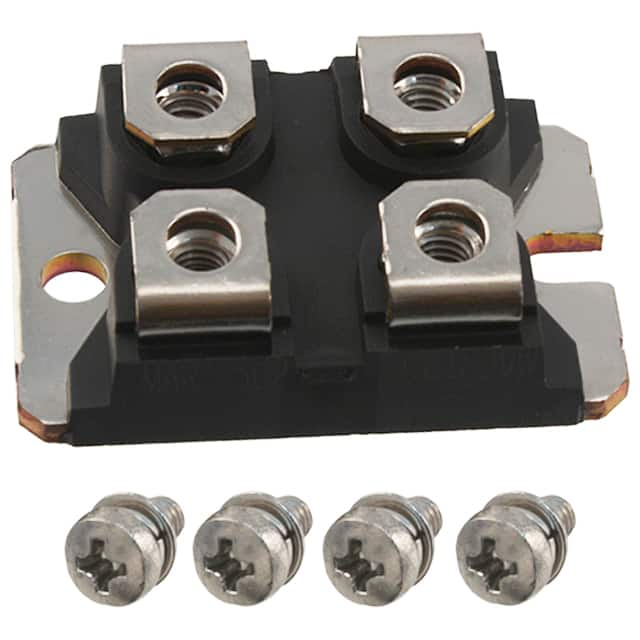STE180NE10
Product Overview
Category
The STE180NE10 belongs to the category of power MOSFETs.
Use
It is used as a high-voltage, N-channel enhancement-mode power MOSFET.
Characteristics
- High voltage capability
- Low input capacitance
- Fast switching speed
- Low on-resistance
Package
The STE180NE10 is typically available in a TO-220 package.
Essence
This MOSFET is essential for power electronics applications requiring high voltage and low on-resistance.
Packaging/Quantity
It is commonly packaged individually and sold in quantities suitable for various applications.
Specifications
- Drain-Source Voltage (VDS): 100V
- Continuous Drain Current (ID): 180A
- On-Resistance (RDS(on)): 0.0045Ω
- Gate-Source Voltage (VGS): ±20V
- Total Gate Charge (Qg): 160nC
- Operating Temperature Range: -55°C to 175°C
Detailed Pin Configuration
The STE180NE10 typically has three pins: 1. Source (S) 2. Gate (G) 3. Drain (D)
Functional Features
- High voltage capability allows it to be used in various power supply and motor control applications.
- Low on-resistance minimizes power dissipation and improves efficiency.
- Fast switching speed enables high-frequency operation in power converters.
Advantages
- Suitable for high-power applications
- Low conduction losses
- Fast switching performance
Disadvantages
- Higher gate drive requirements compared to lower voltage MOSFETs
- May require additional circuitry for protection against overvoltage and overcurrent conditions
Working Principles
The STE180NE10 operates based on the principles of field-effect transistors, where the application of a voltage at the gate terminal controls the flow of current between the drain and source terminals.
Detailed Application Field Plans
The STE180NE10 is widely used in the following applications: - Switched-mode power supplies - Motor drives - Inverters - DC-DC converters - Uninterruptible power supplies (UPS)
Detailed and Complete Alternative Models
Some alternative models to the STE180NE10 include: - IRFP4668PbF - FDPF33N25T - IXFN360N15T2
In conclusion, the STE180NE10 power MOSFET offers high voltage capability, low on-resistance, and fast switching speed, making it suitable for a wide range of power electronics applications. Its advantages include suitability for high-power applications, low conduction losses, and fast switching performance. However, it may require higher gate drive requirements and additional protection circuitry. The detailed pin configuration, functional features, working principles, application field plans, and alternative models provide a comprehensive understanding of this power MOSFET.
Word Count: 366
Lista 10 Vanliga frågor och svar relaterade till tillämpningen av STE180NE10 i tekniska lösningar
What is STE180NE10?
- STE180NE10 is a power MOSFET (Metal-Oxide-Semiconductor Field-Effect Transistor) designed for various technical solutions requiring high power and efficiency.
What are the key specifications of STE180NE10?
- The STE180NE10 features a voltage rating of 100V, a continuous drain current of 180A, and low on-resistance for efficient power handling.
In what applications can STE180NE10 be used?
- STE180NE10 is commonly used in applications such as motor control, power supplies, inverters, and welding equipment due to its high power handling capabilities.
What are the thermal characteristics of STE180NE10?
- The MOSFET has low thermal resistance and is designed to efficiently dissipate heat, making it suitable for high-power applications.
How does STE180NE10 contribute to energy efficiency in technical solutions?
- With its low on-resistance and high current-handling capability, STE180NE10 helps minimize power losses and improve overall energy efficiency in various applications.
What protection features does STE180NE10 offer?
- The MOSFET includes built-in protection against overcurrent, overvoltage, and thermal overload, enhancing the reliability and safety of the technical solutions it's used in.
Can STE180NE10 be used in automotive applications?
- Yes, STE180NE10 is suitable for automotive applications such as electric vehicle powertrains, battery management systems, and onboard chargers due to its high performance and reliability.
Are there any recommended driver circuits for driving STE180NE10?
- It is recommended to use dedicated MOSFET driver circuits to ensure optimal switching performance and to maximize the benefits of STE180NE10 in technical solutions.
What are the mounting and assembly considerations for using STE180NE10?
- Proper heatsinking and PCB layout design are crucial for effective heat dissipation and reliable operation when integrating STE180NE10 into technical solutions.
Where can I find detailed application notes and reference designs for utilizing STE180NE10?
- Detailed application notes, reference designs, and technical support for implementing STE180NE10 in various technical solutions can be found on the manufacturer's website or through authorized distributors.


